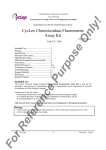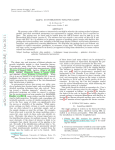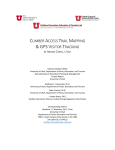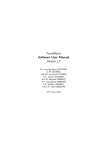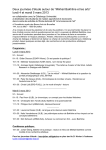Download For Reference Purpose Only!
Transcript
CircuLex Human Chitotriosidase ELISA Kit User’s Manual For Research Use Only, Not for use in diagnostic procedures ELISA Kit for Measuring Human Chitotriosidase On ly! TM CircuLex Human Chitotriosidase ELISA Kit Pu Intended Use................................................ 1 Storage......................................................... 1 Introduction.................................................. 2 Principle of the Assay.................................. 2-3 Materials Provided....................................... 3 Materials Required but not Provided........... 4 Precautions and Recommendations.............. 5 Sample Collection and Storage.....................6 Detailed Protocol.......................................... 7-8 Calculations..................................…............ 9 Measurement Range..................................... 9 Troubleshooting............................................ 9 Reagent Stability.......................................... 10 Assay Characteristics................................... 10-12 Example of Test Results................................13 References.................................................... 14-15 Related Products.......................................... 15 rp os e Cat# CY-8074 ce Intended Use The CycLex Research Product CircuLex Human Chitotriosidase ELISA Kit is used for the quantitative measurement of human chitotriosidase in human serum/plasma, cell extract, cell conditioned medium and other biological samples. en This assay kit is for research use only and not for use in diagnostic or therapeutic procedures. Storage rR ef er • Upon receipt store all components at 4°C. • Don’t expose reagents to excessive light. Fo Cat#: CY-8074 1 Version#: 120710 CircuLex Human Chitotriosidase ELISA Kit User’s Manual For Research Use Only, Not for use in diagnostic procedures On ly! TM Introduction ce Pu rp os e Chitotriosidase was discovered in plasma of patients suffering from Gaucher’s disease; it was found that the 1,000-fold-elevated enzyme originates from lipid-laden macrophages that accumulate in various tissues of Gaucher’s patients (1). Chitotriosidase has subsequently been purified from the spleen of a Gaucher’s patient and its cDNA was cloned from a human macrophages cDNA library (2, 3). This enzyme is a human chitinase member of family 18 glycosyl hydrolases (3–5), and has the capability to hydrolyze chitin. This enzyme is selectively expressed in activated tissue macrophages that accumulate in various tissues of several lysosomal diseases (6). Therefore its activity has been proposed as a biochemical marker of macrophage accumulation in Gaucher’s disease (1, 7). In some other inherited lysosomal storage disorders, especially sphingolipidoses such as Niemann Pick, GM1-gangliosidosis, and Krabbe disease, which involve accumulation of different lipids, more modest elevations in plasma chitotriosidase have been noted (7). Chitotriosidase is the only biomarker identified up to date for the monitoring the efficacy of the extremely costly enzyme-replacement therapy of Gaucher patients and male Fabry patients (8). Elevated levels of serum chitotriosidase were also found in disorders caused by the abnormal activation of immune system, including sarcoidosis (9) and atherosclerosis (10, 11). It has been shown that chitotriosidase activity was elevated up to 55-fold in extracts of atherosclerotic tissue, showing a clear connection between chitotriosidase expression and lipid-laden macrophages inside human atherosclerotic vessel wall (10). Human chitotriosidase also associates with pathogen-driven diseases, and in particular with fungal infections, suggesting the role of this enzyme in host defense against chitin-containing pathogens (12, 13). Other clinical data for instance show that chitotriosidase activity is raised in plasma of African children infected with acute Plasmodium falciparum malaria (14). Additional evidence for a role of chitotriosidase during immunological responses is the observation that the enzyme is shortly and acutely up-regulated both at the level of mRNA and activity following stimulation with prolactin, IFN-γ, TNF α and LPS, but not with IL-10 (15, 16). In the blood stream, tissue macrophages largely secrete newly synthesized 50-kDa chitotriosidase, but about one-third is directly routed to lysosomes and proteolytically processed to the 39-kDa unit that remains catalytically active (17). A common chitotriosidase gene polymorphism leads to a null allele and therefore a defective enzyme activity. In white populations, 30% to 40% of individuals are carriers of this abnormal chitotriosidase allele and approximately 6% are homozygous (1, 18). Principle of the Assay rR ef er en The CycLex Research Product CircuLex Human Chitotriosidase ELISA Kit employs the quantitative sandwich enzyme immunoassay technique. An antibody specific for human chitotriosidase has been pre-coated onto a microplate. Standards and samples are pipetted into the wells and the immobilized antibody binds any human chitotriosidase present. After washing away any unbound substances, an HRP conjugated antibody specific for human chitotriosidase is added to the wells. Following a wash to remove any unbound HRP conjugated antibody, the remaining conjugate is allowed to react with the substrate H2O2-tetramethylbenzidine. The reaction is stopped by addition of acidic solution and absorbance of the resulting yellow product is measured at 450 nm. The absorbance is proportional to the concentration of human chitotriosidase. A standard curve is constructed by plotting absorbance values versus human chitotriosidase concentrations of calibrators, and concentrations of unknown samples are determined using this standard curve. The CycLex Research Product CircuLex Human Chitotriosidase ELISA Kit is designed to measure the concentration of human chitotriosidase in human serum/plasma or cell culture conditioned medium. Fo Cat#: CY-8074 2 Version#: 120710 CircuLex Human Chitotriosidase ELISA Kit User’s Manual For Research Use Only, Not for use in diagnostic procedures Summary of Procedure Add 100 µL of diluted samples to wells Incubate for 1 hour at room temp. Wash the wells On ly! TM Add 100 µL of HRP conjugated anti-human chitotriosidase antibody Wash the wells Add 100 µL of Substrate Reagent Add 100 µL of Stop Solution Pu Measure absorbance at 450 nm rp os e Incubate for 1 hour at room temp. Materials Provided All samples and standards should be assayed in duplicate. The following components are supplied and are sufficient for the one 96-well microplate kit. ce Microplate: One microplate supplied ready to use, with 96 wells (12 strips of 8-wells) in a foil, zip-lock bag with a desiccant pack. Wells are coated with anti-human chitotriosidase antibody as a capture antibody. 10X Wash Buffer: One bottle containing 100 mL of 10X buffer containing 2%Tween®-20. en Dilution Buffer: One bottle containing 50 mL of 1X buffer; use for reconstitution of Human Chitotriosidase Standard and sample dilution. Ready to use. er Human Chitotriosidase Standard: One vial containing 18 ng of lyophilized recombinant human chitotriosidase HRP conjugated Detection Antibody: One bottle containing 12 mL of HRP (horseradish peroxidase) conjugated anti-human chitotriosidase antibody. Ready to use. ef Substrate Reagent: One bottle containing 20 mL of the chromogenic substrate, tetra-methylbenzidine (TMB). Ready to use. rR Stop Solution: One bottle containing 20 mL of 1 N H2SO4. Ready to use. Fo Cat#: CY-8074 3 Version#: 120710 CircuLex Human Chitotriosidase ELISA Kit User’s Manual For Research Use Only, Not for use in diagnostic procedures On ly! TM Materials Required but not Provided • Pipettors: 2-20 µL, 20-200 µL and 200-1000 µL precision pipettors with disposable tips • Precision repeating pipettor • Orbital microplate shaker • Microcentrifuge and tubes for sample preparation rp os e • Vortex mixer • Microplate washer: optional (Manual washing is possible but not preferable) • Plate reader: capable of measuring absorbance in 96-well plates at dual wavelengths of 450/540 nm. Dual wavelengths of 450/550 or 450/595 nm can also be used. The plate can also be read at a single wavelength of 450 nm, which will give a somewhat higher reading. • Software package facilitating data generation and analysis: optional • Reagent reservoirs • Deionized water of the highest quality rR ef er en ce • Disposable paper towels Pu • 500 or 1000 mL graduated cylinder Fo Cat#: CY-8074 4 Version#: 120710 CircuLex Human Chitotriosidase ELISA Kit User’s Manual For Research Use Only, Not for use in diagnostic procedures Precautions and Recommendations • Allow all the components to come to room temperature before use. On ly! TM • All microplate strips that are not immediately required should be returned to the zip-lock pouch, which must be carefully resealed to avoid moisture absorption. • Do not use kit components beyond the indicated kit expiration date. rp os e • Use only the microtiter wells provided with the kit. • Rinse all detergent residues from glassware. • Use deionized water of the highest quality. • Do not mix reagents from different kits. • The buffers and reagents used in this kit contain NaN3 as preservatives. Care should be taken to avoid direct contact with these reagents. • Do not mouth pipette or ingest any of the reagents. Pu • Do not smoke, eat, or drink when performing the assay or in areas where samples or reagents are handled. • Dispose of tetra-methylbenzidine (TMB) containing solutions in compliance with local regulations. • Avoid contact with the acidic Stop Solution and Substrate Solution, which contains hydrogen peroxide. ce • Wear gloves and eye protection when handling immunodiagnostic materials and samples of human origin, and these reagents. In case of contact with the Stop Solution and the Substrate Solution, wash skin thoroughly with water and seek medical attention, when necessary. en • Biological samples may be contaminated with infectious agents. Do not ingest, expose to open wounds or breathe aerosols. Wear protective gloves and dispose of biological samples properly. rR ef er • CAUTION: Sulfuric Acid is a strong acid. Wear disposable gloves and eye protection when handling Stop Solution. Fo Cat#: CY-8074 5 Version#: 120710 CircuLex Human Chitotriosidase ELISA Kit User’s Manual For Research Use Only, Not for use in diagnostic procedures On ly! TM Sample Collection and Storage Serum: Use a serum separator tube and allow samples to clot for 60 ± 30 minutes. Centrifuge the samples at 4°C for 10 minutes at 1,000 x g. Remove serum and assay immediately or store samples on ice for up to 6 hours before assaying. Aliquots of serum may also be stored at below –70°C for extended periods of time. Avoid repeated freeze-thaw cycles. rp os e Plasma: Collect plasma using EDTA-Na2 as the anticoagulant. If possible, collect the plasma into a mixture of EDTA-Na2 and Futhan5 to stabilize the sample against spontaneous in vitro complement activation. Immediately centrifuge samples at 4°C for 15 minutes at 1,000 x g. Assay immediately or store samples on ice for up to 6 hours before assaying. Aliquots of plasma may also be stored at bolow -70°C for extended periods of time. Avoid repeated freeze-thaw cycles. Note: Citrate plasma has not been validated for use in this assay. rR ef er en ce Pu Conditioned medium of cultured cells: Remove any particulates by centrifugation and assay immediately or aliquot and store samples at below -70°C. Avoid repeated freeze-thaw cycles. Fo Cat#: CY-8074 6 Version#: 120710 CircuLex Human Chitotriosidase ELISA Kit User’s Manual For Research Use Only, Not for use in diagnostic procedures On ly! TM Detailed Protocol The CycLex Research Product CircuLex Human Chitotriosidase ELISA Kit is provided with removable strips of wells so the assay can be carried out on separate occasions using only the number of strips required for the particular determination. Since experimental conditions may vary, an aliquot of the Human Chitotriosidase Standard within the kit, should be included in each assay as a calibrator. Disposable pipette tips and reagent troughs should be used for all liquid transfers to avoid cross-contamination of reagents or samples. Preparation of Working Solutions rp os e All reagents need to be brought to room temperature prior to the assay. Assay reagents are supplied ready-to-use, with the exception of 10X Wash Buffer and Human Chitotriosidase Standard. 1. Prepare a working solution of Wash Buffer by adding 100 mL of the 10X Wash Buffer to 900 mL of deionized (distilled) water. Mix well. Store at 4°C for one month or -20°C for long-term storage. 2. Reconstitute Human Chitotriosidase Standard with 0.5 mL of Dilution Buffer. The concentration of the reconstituted human Chitotriosidase should be 36 ng/mL, which is referred as a Master Standard of human chitotriosidase. Pu Prepare Standard Solutions as follows: Use the Master Standard to produce a dilution series (below). Mix each tube thoroughly before the next transfer. The 3,600 pg/mL standard (Std.1) serves as the highest standard. The Dilution Buffer serves as the zero standard (Blank). Volume of Standard 60 µL of Master Standard 300 µL of Std. 1 (4,000 pg/mL) 300 µL of Std. 2 (2,000 pg/mL) 300 µL of Std. 3 (1,000 pg/mL) 300 µL of Std. 4 (500 pg/mL) 300 µL of Std. 5 (250 pg/mL) 300 µL of Std. 6 (125 pg/mL) en ce Std.1 Std.2 Std.3 Std.4 Std.5 Std.6 Std.7 Blank - Dilution Buffer 540 µL 300 µL 300 µL 300 µL 300 µL 300 µL 300 µL 300 µL Concentration 3,600 pg/mL 1,800 pg/mL 900 pg/mL 450 pg/mL 225 pg/mL 112.5 pg/mL 56.25 pg/mL 0 ng/mL er Note: Do not use a Repeating pipette. Change tips for every dilution. Wet tip with Dilution Buffer before dispensing. Unused portions of Master Standard should be aliquoted and stored at below -70°C immediately. Avoid multiple freezes and thaw cycles. Sample Preparation ef • Serum and plasma samples require a 50-fold dilution. e.g. 6 µL serum sample + 294 µL Dilution Buffer rR • Conditioned media of cultured cells require neat to appropriate dilution. Fo Cat#: CY-8074 7 Version#: 120710 CircuLex Human Chitotriosidase ELISA Kit User’s Manual For Research Use Only, Not for use in diagnostic procedures Standard Assay Procedure On ly! TM 1. Remove the appropriate number of microtiter wells from the foil pouch and place them into the well holder. Return any unused wells to the foil pouch, refold, seal with tape and store at 4 °C. 2. Dilute samples with Dilution Buffer. (See “Sample Preparation” above.) 3. Pipette 100 µL of Standard Solutions (Std1-Std7, Blank) and conditioned media of cultured cells or diluted samples in duplicates, into the appropriate wells. rp os e 4. Incubate the plate at room temperature (ca.25°C) for 1 hour, shaking at ca. 300 rpm on an orbital microplate shaker. 5. Wash 4-times by filling each well with Wash Buffer (350 µL) using a squirt bottle, multi-channel pipette, manifold dispenser or microplate washer. 6. Add 100 µL of HRP conjugated Detection Antibody into each well. 7. Incubate the plate at room temperature (ca.25°C) for 1 hour, shaking at ca. 300 rpm on an orbital microplate shaker. Pu 8. Wash 4-times by filling each well with Wash Buffer (350 µL) using a squirt bottle, multi-channel pipette, manifold dispenser or microplate washer. 9. Add 100 µL of Substrate Reagent. Avoid exposing the microplate to direct sunlight. Covering the plate with e.g. aluminum foil is recommended. Return Substrate Reagent to 4 °C immediately after the necessary volume is removed. ce 10. Incubate the plate at room temperature (ca.25°C) for 10-20 minutes, shaking at ca. 300 rpm on an orbital microplate shaker. The incubation time may be extended up to 30 minutes if the reaction temperature is below than 20 °C. en 11. Add 100 µL of Stop Solution to each well in the same order as the previously added Substrate Reagent. er 12. Measure absorbance in each well using a spectrophotometric microplate reader at dual wavelengths of 450/540 nm. Dual wavelengths of 450/550 or 450/595 nm can also be used. Read the microplate at 450 nm if only a single wavelength can be used. Wells must be read within 30 minutes of adding the Stop Solution. rR ef Note-1: Complete removal of liquid at each step is essential to good performance. After the last wash, remove any remaining Wash Buffer by aspirating or decanting. Invert the plate and blot it against clean paper towels. Note-2: Reliable standard curves are obtained when either O.D. values do not exceed 0.25 units for the blank (zero concentration), or 3.0 units for the highest standard concentration. Note-3: If the microplate reader is not capable of reading absorbance greater than the absorbance of the highest standard, perform a second reading at 405 nm. A new standard curve, constructed using the values measured at 405 nm, is used to determine human chitotriosidase concentration of off-scale samples. The readings at 405 nm should not replace the on-scale readings at 450 nm. Fo Cat#: CY-8074 8 Version#: 120710 CircuLex Human Chitotriosidase ELISA Kit User’s Manual For Research Use Only, Not for use in diagnostic procedures On ly! TM Calculations rp os e Average the duplicate readings for each standard, control, and sample and subtract the average zero standard optical density. Plot the optical density for the standards versus the concentration of the standards and draw the best curve. The data can be linearized by using log/log paper and regression analysis may be applied to the log transformation. To determine the human chitotriosidase concentration of each sample, first find the absorbance value on the y-axis and extend a horizontal line to the standard curve. At the point of intersection, extend a vertical line to the x-axis and read the corresponding human chitotriosidase concentration. If the samples have been diluted, the concentration read from the standard curve must be multiplied by the dilution factor. 1. The dose-response curve of this assay fits best to a sigmoidal 4-parameter logistic equation. The results of unknown samples can be calculated with any computer program having a 4-parameter logistic function. It is important to make an appropriate mathematical adjustment to accommodate for the dilution factor. 2. Most microplate readers perform automatic calculations of analyte concentration. The calibration curve is constructed by plotting the absorbance (Y) of calibrators versus log of the known concentration (X) of calibrators, using the 4-parameter function. Alternatively, the logit log function can be used to linearize the calibration curve (i.e. logit of absorbance (Y) is plotted versus log of the known concentration (X) of calibrators). Pu Measurement Range The measurement range is 56.25 pg/mL to 3,600 pg/mL. Any sample reading higher than the highest standard should be diluted with Dilution Buffer in higher dilution and re-assayed. Dilution factors need to be taken into consideration in calculating the human chitotriosidase concentration. ce Troubleshooting en 1. Human Chitotriosidase Standard should be run in duplicate, using the protocol described in the Detailed Protocol. Incubation times or temperatures significantly different from those specified may give erroneous results. 2. Poor duplicates, accompanied by elevated values for wells containing no sample, indicate insufficient washing. If all instructions in the Detailed Protocol were followed accurately, such results indicate a need for washer maintenance. rR ef er 3. Overall low signal may indicate that desiccation of the plate has occurred between the final wash and addition of Substrate Reagent. Do not allow the plate to dry out. Add Substrate Reagent immediately after wash. Fo Cat#: CY-8074 9 Version#: 120710 CircuLex Human Chitotriosidase ELISA Kit User’s Manual For Research Use Only, Not for use in diagnostic procedures On ly! TM Reagent Stability All of the reagents included in the CycLex Research Product CircuLex Human Chitotriosidase ELISA Kit have been tested for stability. Reagents should not be used beyond the stated expiration date. Upon receipt, kit reagents should be stored at 4°C, except the reconstituted Human Chitotriosidase Standard must be stored at below -70°C. Coated assay plates should be stored in the original foil bag sealed by the zip lock and containing a desiccant pack. Assay Characteristics rp os e 1. Sensitivity The limit of detection (defined as such a concentration of human chitotriosidase giving absorbance higher than mean absorbance of blank* plus three standard deviations of the absorbance of blank: A blank + 3SD blank) is better than 48.3 pg/ml of sample. * Dilution Buffer is pipetted into blank wells. Typical Standard Curve Human Chitotriosidase Standard Curve Pu 3.0 2.5 ce A450 2.0 1.5 0.5 0.0 en 1.0 1.0 2.0 3.0 Human Chitotriosidase conc. (ng/ml) 4.0 rR ef er 0.0 Fo Cat#: CY-8074 10 Version#: 120710 CircuLex Human Chitotriosidase ELISA Kit User’s Manual For Research Use Only, Not for use in diagnostic procedures 2. Precision On ly! TM Intra-assay Precision (Precision within an assay) Three samples of known concentration were tested sixteen times on one plate to assess intra-assay precision. • Intra-assay (Within-Run, n=16) CV=2.1-2.6 % rR rp os e Pu ce ef er en 1 2 3 4 5 6 7 8 9 10 11 12 13 14 15 16 MAX. MIN. MEAN S.D. C.V. Human Chitotriosidase conc. (ng/ml) Serum 1 Serum 2 Serum 3 19.01 10.46 5.95 18.31 10.04 5.60 18.39 10.32 5.72 18.46 10.52 5.61 18.62 10.44 5.61 18.51 9.96 5.64 18.31 9.98 5.58 17.72 9.86 5.74 18.38 10.60 5.57 17.89 10.23 5.54 18.71 10.18 5.57 18.85 10.59 5.62 18.57 10.41 5.73 18.34 9.80 5.47 18.10 10.04 5.69 17.64 10.30 5.47 19.01 10.60 5.95 17.64 9.80 5.47 18.36 10.23 5.63 0.38 0.26 0.12 2.1% 2.6% 2.1% Fo Cat#: CY-8074 11 Version#: 120710 CircuLex Human Chitotriosidase ELISA Kit User’s Manual For Research Use Only, Not for use in diagnostic procedures On ly! TM Inter-assay Precision (Precision between assays) Three samples of known concentration were tested in five separate assays to assess inter-assay precision. • Inter-assay (Run-to-Run, n=5) CV=3.07 - 5.02 % Hu Chitotriosidase conc. (ng/ml) 1 2 3 4 5 MAX. MIN. MEAN S.D. C.V. Serum 2 19.6 19.6 20.5 20.4 21.2 21.2 19.6 20.3 0.70 3.47% Serum 3 9.9 9.7 9.9 10.5 10.0 10.5 9.7 10.0 0.31 3.07% rp os e Serum 1 33.9 35.0 32.4 32.7 36.6 36.6 32.4 34.1 1.71 5.02% Pu 3. Linearity To assess the linearity of the assay, samples containing and/or spiked with high concentrations of chitotriosidase were serially diluted with the Dilution Buffer to produce samples with values within the dynamic range of the assay. ce Linearity ● Serum 1 ▲ Serum 2 ◆ Serum 3 en 0.8 0.5 er Human Chitotriosidase conc.(ng/ml) 1.0 rR ef 0.3 Fo Cat#: CY-8074 0.0 0 0.5 1 1.5 2 2.5 Serum Dilution Ratio (1/100) 12 Version#: 120710 CircuLex Human Chitotriosidase ELISA Kit User’s Manual For Research Use Only, Not for use in diagnostic procedures On ly! TM Example of Test Results Fig.1 Chitotriosidase concentrations in healthy Japanese volunteers sera (n=36) and CRP positive sera (n=35) 45 rp os e 40 Hu Chitotriosidase conc. (ng/ml) 35 30 20 15 ce 10 Pu 25 5 CRP + Normal rR ef er en 0 Fo Cat#: CY-8074 13 Version#: 120710 CircuLex Human Chitotriosidase ELISA Kit User’s Manual For Research Use Only, Not for use in diagnostic procedures On ly! TM References 1. Hollak, C. E., van Weely, S., van Oers, M. H. and Aerts, J. M. (1994). Marked elevation of plasma chitotriosidase activity. A novel hallmark of Gaucher disease. J. Clin. Invest. 93: 1288. 2. Renkema, G. H., Boot, R. G., Muijsers,A.O., Donker-Koopman, W. E. and Aerts, J. M. (1995). Purification and characterization of human chitotriosidase, a novel member of the chitinase family of proteins. J. Biol. Chem. 270: 2198. rp os e 3. Boot, R. G., Renkema, G. H., Strijland, A., van Zonneveld, A. J. and Aerts, J. M. (1995). Cloning of a cDNA encoding chitotriosidase, a human chitinase produced by macrophages. J. Biol. Chem. 270: 26252. 4. Hakala BE, White C, Recklies AD. (1993) Human cartilage gp-39, a major secretory product of articular chondrocytes and synovial cells, is a mammalian member of chitinase protein family. J Biol Chem. 268: 25803. 5. Renkema GH, Boot RG, Au FL, Donker-Koopman WE, Strijland A, Muijsers AO, Hrebicek M, Aerts JM. (1998) Chitotriosidase, a chitinase, and the 39-kDa human cartilage glycoprotein, a chitin-binding lectin, are homologues of family 18 glycosyl hydrolases secreted by human macrophages. Eur J Biochem. 251: 504. Pu 6. Aerts, J. M., and Hollak, C. E. (1997) Plasma and metabolic abnormalities in Gaucher's disease. Baillieres Clin. Haematol. 10: 691. 7. Guo Y, He W, Boer AM, Wevers RA, de Bruijn AM, Groener JE, Hollak CE, Aerts JM, Galjaard H, van Diggelen OP. (1995) Elevated plasma chitotriosidase activity in various lysosomal storage disorders. J Inher Metab Dis. 18: 717. ce 8. Vedder, A.C., Cox-Brinkman, J., Hollak, C.E. et al. (2006) Plasma chitotriosidase in male Fabry patients: A marker for monitoring lipid-laden macrophages and their correction by enzyme replacement therapy. Mol. Genet. Metab. 89: 239. en 9. Grosso, S., Margollicci, M.A., Bargagli, E. et al. (2004) Serum levels of chitotriosidase as a marker of disease activity and clinical stage in sarcoidosis. Scand. J. Clin. Lab. Invest.. 64: 57. er 10. Boot, R.G., van Achterberg, T.A., van Aken, B.E. et al. (1999) Strong induction of members of the chitinase family of proteins in atherosclerosis: chitotriosidase and human cartilage gp-39 expressed in lesion macrophages. Arterioscler. Thromb. Vasc. Biol. 19: 687. 11. Artieda, M., Cenarro, A., Ganan, A. et al. (2003) Serum chitotriosidase activity is increased in subjects with atherosclerosis disease. Arterioscler. Thromb. Vasc. Biol. 23: 1645. ef 12. Labadaridis, J., Dimitriou, E., Costalos, C. et al. (1998) Serial chitotriosidase activity estimations in neonatal systemic candidiasis. Acta Paediatr. 87: 605. rR 13. Labadaridis, I., Dimitriou, E., Theodorakis, M. et al. (2005) Chitotriosidase in neonates with fungal and bacterial infections. Arch. Dis. Child Fetal Neonatal Ed. 90: F531. 14. Barone, R., Simpore, J., Malaguarnera, L., Pignatelli, S. And Musumeci, S. (2003) Plasma Fo Cat#: CY-8074 14 Version#: 120710 TM On ly! CircuLex Human Chitotriosidase ELISA Kit User’s Manual For Research Use Only, Not for use in diagnostic procedures chitotriosidase activity in acute Plasmodium falciparum malaria. Clin. Chim. Acta 331: 79. 15. Di Rosa, M., Musumeci, M., Scuto, A., Musumeci, S. and Malaguarnera, L. (2005) Effect of interferon-gamma, interleukin-10, lipopolysaccharide and tumor necrosis factor-alpha on chitotriosidase synthesis in human macrophages. Clin. Chem. Lab. Med. 43: 499. 16. Malaguarnera, L.,Musumeci,M., Licata, F., Di Rosa,M.,Messina, A. and Musumeci, S. (2004) Prolactin induces chitotriosidase gene expression in human monocyte-derived macrophages. Immunol. Lett. 94: 57. rp os e 17. Renkema, G. H., Boot, R. G., Strijland, A. Donker-koopman, W. E., van den Berg, M., Muijsers, A. O., and Aerts, J. M. F. G. (1997) Synthesis, sorting, and processing into distinct isoforms of human macrophage chitotriosidase. Eur. J. Biochem. 244: 279 18. Eiberg H, den Tandt WR. (1997) Assignment of human plasma methylumbelliferyl -tetra-N-acetylchitotetraoside or chitinase to chromosome 19 by a linkage study. Hum Genet. 101: 205. Related Products Pu * CircuLex Human Chitotriosidase ELISA Kit: Cat# CY-8074 * CycLex Chitotriosidase Fluorometric Assay Kit: Cat# CY-1249 * Chitotriosidase: Cat# CY-E1249 en CycLex Co., Ltd. 1063-103 Terasawaoka Ina, Nagano 396-0002 Japan Fax: +81-265-76-7618 e-mail: [email protected] URL: http://www.cyclex.co.jp ce PRODUCED BY rR ef er CycLex/CircuLex products are supplied for research use only. CycLex/CircuLex products and components thereof may not be resold, modified for resale, or used to manufacture commercial products without prior written approval from CycLex Co., Ltd.. To inquire about licensing for such commercial use, please contact us via email. Fo Cat#: CY-8074 15 Version#: 120710















